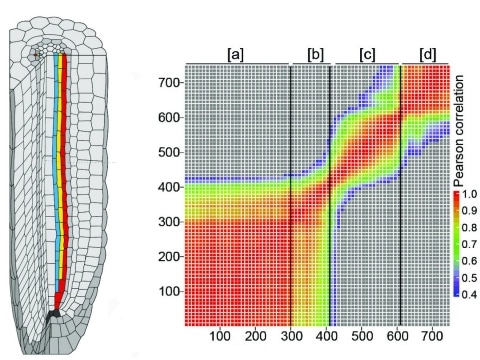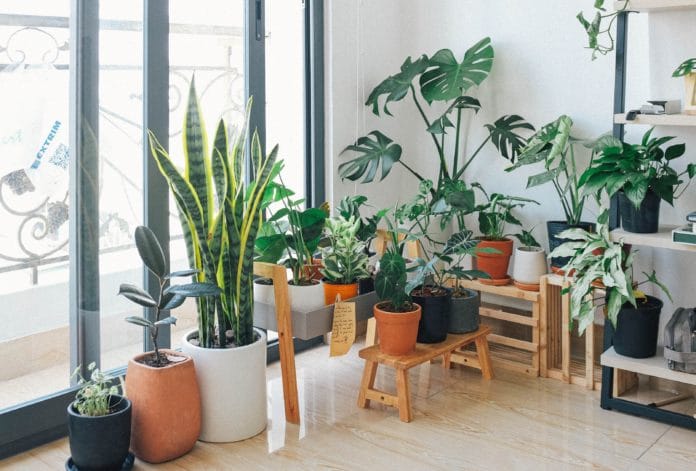The plant root grows indeterminately. Continual birth and maturation of cells in a gradient along the longitudinal root axis requires tissue-wide coordination of cell division with cell differentiation. Within the root, a single cell file of developing protophloem is surrounded by other tissues, with each cell type differentiating at its characteristic pace.
Despite communication of protophloem cells with the surrounding environment, the developmental program of phloem within the plant’s vascular system is accelerated compared with certain surrounding cell types.
Phloem is a highly specialized vascular tissue that forms an interconnected network of continuous strands throughout a plant’s body. It transports sugars, nutrients, and a range of signaling molecules between leaves, roots, flowers, and fruits.
As a result, phloem is central to plant function. Understanding how the phloem network is initiated and developed is essential for future agriculture, forestry, and biotechnology applications. It could reveal how to better transport this sugar energy to needed.
How do plants build a sugar lane in a multi-lane highway?
The problem that has long puzzled plant scientists is how a single instructive gradient of proteins can stage the construction phases across all the different specialized cell files (highway lanes) present in roots. Plant scientists have been working on resolving how one cell type reads the same gradient as its neighbors but interprets it differently to stage its specialized development.
In a paper published in Science, an international team of scientists presents a detailed blueprint of how plants construct phloem cells—the tissue responsible for transporting and accumulating sugars and starch in the parts of the plant that we harvest (seeds, fruits, and storage tubers) to feed much of the world.
This pivotal research reveals how global signals in root meristems coordinate distinct maturation phases of the phloem tissue.

Over the past 15 years, researchers in Yrjö Helariutta’s teams at the University of Cambridge and University of Helsinki have uncovered the central role of cell-to-cell communication and complex feedback mechanisms involved in vascular patterning. This new research, undertaken with collaborators at New York University and North Carolina State University, reveals how this single lane of phloem cells is constructed independently of surrounding cells.
The Sainsbury/Helsinki group dissected each step in constructing the phloem cell file (the sugar transport lane) in the model plant Arabidopsis thaliana using single-cell RNA-seq and live imaging. Their work showed how the proteins that control the broad maturation gradient of the root interact with the genetic machinery that explicitly controls phloem development.
This mechanism appears to help the phloem cell file to fast-track maturation using its machinery to interpret the maturation cues. Pawel Roszak, co-first-author of the study and researcher at the Sainsbury Laboratory Cambridge University (SLCU), explains: “We have shown how global signals in the root meristem interact with the cell type-specific factors to determine distinct phases of phloem development at the cellular resolution. Using cell sorting followed by deep, high-resolution single-cell sequencing of the underlying gene regulatory network revealed a ‘seesaw’ mechanism of reciprocal genetic repression that triggers rapid developmental transitions.”
The group also showed how phloem development is staged over time, with early genetic programs inhibiting late genetic programs and vice versa—just as the road asphalt-laying work crews’ hand over construction to lane painters in the latter stages of highway construction. In addition, they showed how early phloem regulators instructed specific genes to split the phloem cells into two different subtypes—like the construction of a fork in the road leading to two separate destinations.
Co-leader of the work, Yrjö Helariutta, said his teams’ reconstruction of the steps from birth to terminal differentiation of protophloem in the Arabidopsis root exposed the steps. Helariutta said: “Broad maturation gradients interfacing with cell-type-specific transcriptional regulators to stage cellular differentiation is required for phloem development.”
“By combining single-cell transcriptomics with live imaging, here we have mapped the cellular events from the birth of the phloem cell to its terminal differentiation into phloem sieve element cells. This allowed us to uncover genetic mechanisms that coordinate cellular maturation and connect the timing of the genetic cascade to broadly expressed master regulators of meristem maturation. The precise timing of developmental mechanisms was critical for proper phloem development, with apparent ‘fail safe’ mechanisms to ensure transitions.”
New York University researchers provided several key technical tools for the project. Kenneth Birnbaum, professor in the Department of Biology and the Center for Genomics and Systems Biology, and Dennis Shasha, professor of computer science at the Courant Institute of Mathematical Sciences, contributed to the analysis of single-cell RNA-seq data, developing the computational models that revealed genetic networks involved in the shift of development programs—i.e., the crew shifts in highway construction. Birnbaum’s lab also shared long-term live imaging techniques that enabled the research team to “watch” phloem cells progress from birth to full maturation over days under the microscope. The long-term microscopy helped show the coordination of the timing of the “lane-splitting” and phloem enucleation events to the molecular state of cells.
“This is a Golden Age for discovery in biology with new tools that help us connect the molecular state of individual cells with real-time observations of the cell,” said Birnbaum. “These single-cell measurements and live imaging techniques are to the cell what satellite imaging is for the earth. Our phloem project shows the potential of these tools to understand the development of plant cells, in particular, those that are so crucial to human nutrition.”
The researchers plan to explore further the evolution of these mechanisms and whether these steps are replicated in other regions of plants and other plant species.
Journal Reference
- Pawel Roszak, et al., Cell-by-cell dissection of phloem development links a maturation gradient to cell specialization. Science 24 Dec 2021 Vol 374, Issue 6575 DOI: 10.1126/science.aba5531
